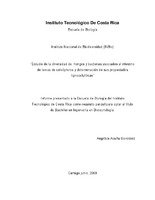Mostrar el registro sencillo del ítem
Estudio de la diversidad de hongos y bacterias asociados al intestino de larvas de coleópteros y determinación de sus propiedades lignocelulíticas
| dc.contributor.author | Acuña-González, Angélica | es_CR |
| dc.date.accessioned | 2010-05-26T17:07:17Z | es_CR |
| dc.date.accessioned | 2011-11-25T22:31:06Z | |
| dc.date.available | 2010-05-26T17:07:17Z | es_CR |
| dc.date.available | 2011-11-25T22:31:06Z | |
| dc.date.issued | 2009 | es_CR |
| dc.identifier.uri | https://hdl.handle.net/2238/552 | es_CR |
| dc.description | Proyecto de Graduación (Bachillerato en Ingeniería en Biotecnología) Instituto Tecnológico de Costa Rica, Escuela de Biología, 2009. | es_CR |
| dc.description.abstract | Es importante comprender el proceso de conversión de la biomasa a azúcares simples y los microorganismos responsables del mismo para poder obtener productos útiles como biocombustibles a partir de la misma. En el presente trabajo se aislaron bacterias y hongos del intestino de larvas de coleópteros y se identificaron mediante marcadores moleculares; además se realizaron ensayos enzimáticos para determinar algunas de sus propiedades lignocelulíticas. Se obtuvieron larvas de cinco familias de coleóptera (Elateridae, Scarabaeidae, Cerambicidae, Passalidae y Tenebrionidae), y se aislaron e identificaron 109 bacterias y 74 hongos del proctodeo de las larvas. Las clases de bacterias con mayor cantidad de individuos fueron Gammaproteobacterias, Firmicutes y Actinomycetales, del total un 20% pudo degradar carboximetilcelulosa (CMC) in vitro. En los hongos predominó el orden Hypocreales, y un 47% de los hongos aislados pudo digerir CMC y un 35 % lignina. En este trabajo se comprobó que el intestino de larvas de escarabajos del orden coleóptera constituye una buena fuente para la búsqueda de microorganismos debido a la alta diversidad de especies de hongos y bacterias que posee y se demostró la actividad lignocelulítica presente en gran parte de las bacterias y los hongos aislados. | es_CR |
| dc.description.abstract | It is important to understand the process of converting the biomass into simple sugars and the responsible microorganisms of this process in order to obtain value-added products such as biofuels. In the present work, we isolated bacteria and fungus from the hindgut of larvae which were identified using molecular techniques; parallel enzymatic assays were made to determine some of the lignocelullolytic activity from the isolated microbial. Larvae were obtained from five families of coleoptera (Elateridae, Scarabaeidae, Cerambycidae, Passalidae y Tenebrionidae), there were 109 bacteria and 74 fungus isolated and identified from the hindgut of larvae. The dominant classes of bacteria were Gammaproteobacterias, Firmicutes and Actinomycetales, 20% out of that bacteria population was able to hydrolyze carboxymethylcelullose (CMC). In the fungus population, the majority belongs to the Hypocreales order, 47% of the fungus could degrade CMC and 35% digested lignin. This study suggests that the hindgut of larvae (orden: coleoptera) constitutes a potential source to search for microorganisms with enzymatic activity due to the high diversity of species of fungus and bacteria isolated and because most of them show lignocelullolytic activity. | |
| dc.format.extent | 297495 bytes | es_CR |
| dc.format.extent | 1493126 bytes | es_CR |
| dc.format.mimetype | application/pdf | es_CR |
| dc.format.mimetype | application/pdf | es_CR |
| dc.language.iso | es | es_CR |
| dc.publisher | Instituto Tecnológico de Costa Rica. | es_CR |
| dc.rights | acceso abierto | es |
| dc.subject | Marcador molecular | es_CR |
| dc.subject | Coleóptera | es_CR |
| dc.subject | Carboximetilcelulosa | es_CR |
| dc.subject | Lignina | es_CR |
| dc.subject | BIOT | es_CR |
| dc.title | Estudio de la diversidad de hongos y bacterias asociados al intestino de larvas de coleópteros y determinación de sus propiedades lignocelulíticas | es_CR |
| dc.type | proyecto fin de carrera | es |



